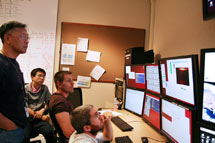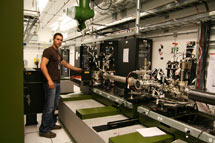
Handy Links
SLAC News Center
SLAC Today
- Subscribe
- Archives: Feb 2006-May 20, 2011
- Archives: May 23, 2011 and later
- Submit Feedback or Story Ideas
- About SLAC Today
SLAC News
Lab News
- Interactions
- Lightsources.org
- ILC NewsLine
- Int'l Science Grid This Week
- Fermilab Today
- Berkeley Lab News
- @brookhaven TODAY
- DOE Pulse
- CERN Courier
- DESY inForm
- US / LHC
SLAC Links
- Emergency
- Safety
- Policy Repository
- Site Entry Form

- Site Maps
- M & O Review
- Computing Status & Calendar
- SLAC Colloquium
- SLACspeak
- SLACspace
- SLAC Logo
- Café Menu
- Flea Market
- Web E-mail
- Marguerite Shuttle
- Discount Commuter Passes
-
Award Reporting Form
- SPIRES
- SciDoc
- Activity Groups
- Library
Stanford
Around the Bay
Hard X-rays Reach LCLS Pump Probe Instrument
On June 7, the X-ray Pump Probe instrument became the first of the Linac Coherent Light Source's scientific instruments to receive hard X-rays.
"This is a big milestone for everyone involved," said instrument scientist David Fritz. "Now the fun begins!"
The XPP instrument will be the third of LCLS's six instruments to go online, but the first hard X-ray instrument. "Hard" X-rays have higher energies and shorter wavelengths than "soft" X-rays, so they penetrate further into materials. This instrument will first "pump" samples with an optical-wavelength laser beam to initiate a reaction or push the sample into an excited state. Quickly following the "pump," X-rays will strike the sample to "probe," or take an image. By stringing together multiple images taken with different time intervals between "pump" and "probe" light, scientists hope to create movies of molecules in motion.
Other X-ray pump probe facilities exist, but the XPP instrument will be unique because of LCLS's incredibly short, intense X-ray pulses. The smaller time frame will allow scientists to collect their images with better timing and produce clearer pictures.
The XPP team is taking a phased approach to commissioning the instrument, which will stretch over the summer. They will begin by testing the instrument with only a few pieces in place, for perhaps a week or so, and then bring in new pieces of equipment. Right now, they only have four devices installed in their experimental hutch. More devices, required to properly tailor and characterize the X-ray beam, will be rolling in over the summer.
"This gives us time to react if something is wrong," Fritz said. Many of the X-ray components will be commissioned in small groups, rather than as a whole, allowing the XPP team to carefully check each piece of equipment.
Over the past few months, the XPP team has not only been receiving and installing equipment, but also meeting all of the safety requirements to use the beamline. With most of that work behind them, they now focus on readying the XPP instrument for upcoming experiments. The first user groups will arrive in mid October, with a total of fifteen groups slated for the fall and winter.
"We have a huge workload ahead of us," Fritz said. "It's going to be crazy busy in the fall and winter."
óJulie Karceski
SLAC Today, June 9, 2010

